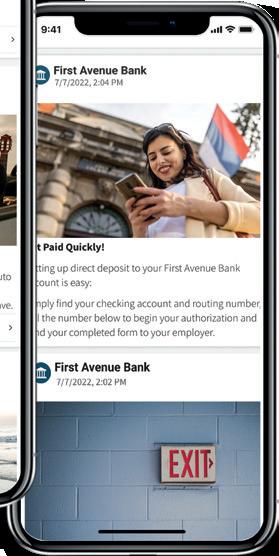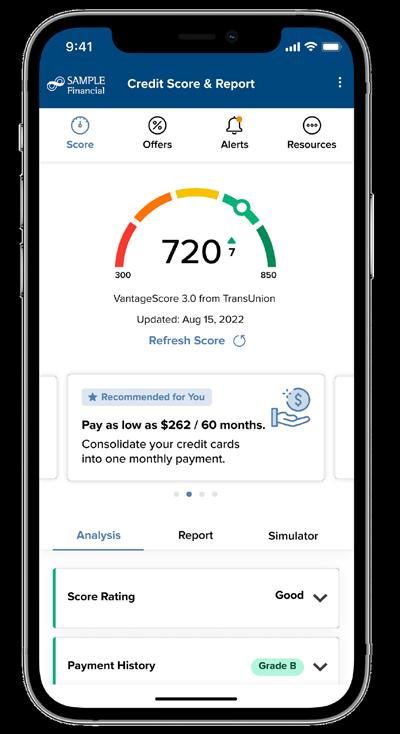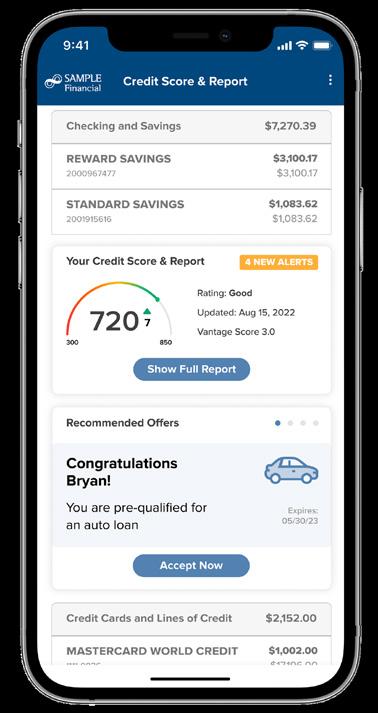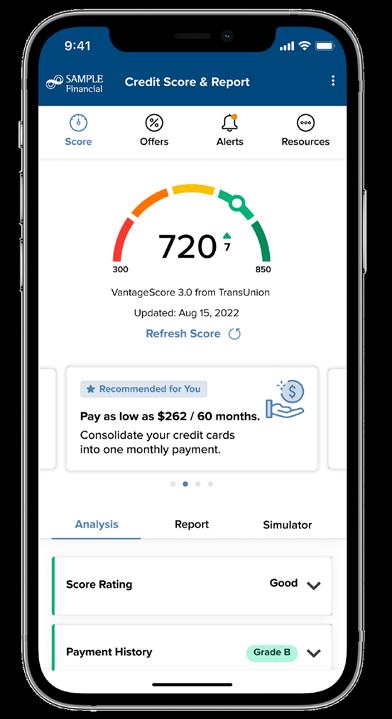
THE VENETIAN, THE PALAZZO & THE SANDS EXPO LAS VEGAS, NEVADA, USA


THE VENETIAN, THE PALAZZO & THE SANDS EXPO LAS VEGAS, NEVADA, USA








Banking Circle’s proprietary technology enables Payments businesses and Banks of any scale to seize opportunities, compete and grow.




From multi-currency accounts to real-time FX, international payments to local clearing, we’re quick, low-cost, and secure.
Bypass old, bureaucratic and expensive systems and enable global banking services for your clients.

bankingcircle.com


From serving up a fireside chat with global tennis legend Serena Williams to bringing out rock & roll legends FOREIGNER to perform live in concert, Money20/20 USA is once again living up to its reputation as the mustattend destination show.

As well as these iconic superstars, Money20/20 USA is bringing together once again the crème de la crème of the payments, banking, fintech and financial

services world to share their stories, innovative ideas and unique perspectives. Back in June, Money20/20 Europe in Amsterdam smashed records with more than 220 press representatives from 70-plus media outlets, 90 countries represented, 380 sponsors and 2,300 companies in attendance. As the organisers told us: “We smashed our own records and that’s because the fintech community knows where to meet up and show out.”
So here we are in Las Vegas once again where this year’s agenda is focusing on stories told through four key areas – vulnerability, defence and offence, chain reactions and experiences (find out more on page 7).



And, in this special edition supplement for Money20/20 USA, The Fintech Times brings you fantastic viewpoints from the most influential players in financial technology, including some of the brilliant speakers that we’ll see on
stage over the three days in The Venetian, The Palazzo, and Sands Expo.
...Psssst! Turn to page 23 to find out details of our Money20/20 USA networking event with partners ebankIT and Mitek as we support The Fintech Power 50 with its US launch of the 2022 Annual Guide. Hope to see you there!
Globalisation and digital transformation have radically altered the front-end of many industries over the past decade or so. But while the customer experience has been revolutionised, the back-end processes in many industries remain largely unchanged.
In many ways, the world is actually becoming smaller through this transformation: I can buy something online from a different country and expect a seamless online journey and fast delivery. However, much of the innovation we are seeing across industries has not extended to the underlying infrastructure, which often remains outdated – and disconnected.
In the payments world, there is a real lack of interoperability, whether it’s between payment systems and schemes, the connections between different geographical markets, or even between fiat and digital currencies. As companies accelerate the digitalisation of their customer and supplychain interactions, there is a growing need for modern-age financial solutions.
New players have disrupted the status quo in banking

and payments, but in this new landscape there is a need for back-end financial services providers who can handle the nuances of infrastructure, leaving fintechs to focus on their services and their customers.
The banking and financial services sector is seeing some really interesting trends at the moment. Following the 2008 financial crisis, fintechs came into the market and each attacked specific parts of the value chain. That shook things up, as these new entrants were providing better customer service, and in some cases were both cheaper and faster than the incumbents.
But a decade on, we’re seeing yet more change –fintechs are now looking to offer a range of products and services that combine the benefits of an efficient user experience and trust in a brand. Organisations are
rebundling the products that were unbundled during the first wave of disruption. That, coupled with the accelerated digitalisation driven by the pandemic, has led to businesses increasingly recognising the value of delivering multiple solutions over a single platform online. Multi-solution platforms are great for improving customer stickiness – they allow you to go beyond solving just one problem for the customer, and instead to offer a complete lifecycle of financial services. By expanding their propositions, fintechs can ultimately better serve the end-customer. But
There is great opportunity for financial services firms to continue to harness digitalisation and innovation in the current landscape to do that well, they need to provide both the services that customers want, as well as those that they might need but not yet realise it – all without compromising on brand value or mission. It can be a tough balance to strike, but when
done well, bundling delivers competitive advantage to individual organisations and improves the fintech industry’s value as a whole.
According to the latest Global Banking Annual Review from McKinsey, the valuation gap between the leaders in the banking industry and those trailing behind is widening, and capital markets are anticipating a ‘great divergence’ between the leaders and followers.
Examining how financial services firms can futureproof their business models, the report suggests that ‘top performers bring customers into an ecosystem, connecting them with other services and building a dynamic and distinctive customer experience’.
It's clear that there is great opportunity for financial services firms to continue to harness digitalisation and innovation in the current landscape, with rebundling as the latest phase of the fintech evolution. But the puzzle piece that still needs connecting is the interoperability of financial systems and spaces, and the connections between global markets.
We see ourselves at Banking Circle Group as

a bridge to create that interoperability. We were built for the digital economy, and as a multi-solution platform we enable payment companies, banks and global marketplaces to deliver cross-border banking and embedded finance products to their own customers through our next generation technology.
We want to facilitate easy movement between financial systems and services, regardless of the markets that our clients and their own customers are in. As a back-end provider for other financial services businesses, our focus is on taking away the complexity and handling the infrastructure, leaving our clients to focus on what they do best.
At the centre of our ecosystem is Banking Circle S.A., a payments bank that is fully licensed yet free from the legacy systems that can make traditional business banking slow and expensive. The bank delivers global payments and banking services by connecting to the world’s clearing systems and was built with a mission to increase efficiency and reduce the costs around cross-border transactions.

Since its launch in 2016, Banking Circle has grown rapidly, and we have committed significant investment to the integration of a vast network of local clearing and payments schemes to build a super-correspondent banking network. Add to that the rich set of complementary solutions within our
Group ecosystem, and we have a full stack solution for today’s commerce players.
As a Group we have already processed more than $250billion in transactions volumes and are growing at pace. Now, we’re preparing for a bigger expansion into the US market. It’s a region I see our interoperability strategy as being a great fit for, as the North American financial system is unique and remains fragmented. We’ll be providing banking, payments and embedded finance services. Through Banking Circle S.A., we won’t be going up against existing local banks in the region, but rather will be enabling those in the US to operate in and out of the country and into any country in Europe where we have clearing access, and vice versa. Through us, banks and financial institutions in the US can enable their own customers to operate in Europe and receive
domestic payments from the region. Two of our Group businesses are already live in the US, which means we can also offer business payments and card issuing through B4B Payments, and embedded finance from YouLend. Our focus in the US will really be on enhancing the global payment capabilities of our clients in the region and making cross-border trade easier, all by leveraging our financial technology platform to act as a connecting bridge.
About Banking Circle Banking Circle Group is the financial technology platform for global commerce. The world’s leading digital businesses rely on Banking Circle Group to deliver cross-border banking and embedded finance products through next generation technology. Businesses in the ecosystem include Banking Circle S.A., YouLend, B4B Payments, SEPAexpress and Biller. Web: www.bankingcircle group.com
LinkedIn: linkedin.com/ company/bankingcircle-group


Last year at Money20/20 USA, more than 300 speakers engaged in four days of conversations with an audience of more than 8,000 attendees, from over 2,500 companies. So, what can we expect in 2022? Let's hear from Tracey Davies, president of Money20/20.


“Every year I get asked to share what I'm looking forward to at Money20/20 Las Vegas. Every year I find it incredibly difficult to pick from all of the brilliant things our team has planned to shape the narrative around fintech.
is impacting their lives and businesses – from OnlyFans content creators to Web3 startups to huge global banks – it's changing the way we all do business, so it's important that we look at it from every angle.


"One thing I am interested in is the growing focus on embedded finance – it features in every part of our agenda and is becoming an increasingly crucial driver of growth in the industry. We've got some incredible speakers from all walks of life talking about how embedded finance
"Beyond embedded finance, I think I'm most excited about the sheer diversity of the speakers, businesses and attendees we'll have this year. Since founding our Do.Better.Togther. initiatives it's been our mission to create an equitable platform that gives strong representation to diverse speakers. And, while we always have more work to do, this year in Las Vegas, almost 48 per cent of our speakers are women. It's important to us that we use our platform to showcase diverse voices from across our industry."
This year’s event has four key themes – let’s hear more from the Money20/20 team.
“We will be talking about models like open finance and embedded services that will change how money moves and who moves it. We will be talking about safe data and cyber security on all levels. Every solution starts with understanding the possibilities – so more than anything we will be talking about what is possible!”
“This October many of the conversations on our stages will be told through the lens of fraud, regulation, and policy. We want to hear stories on revolutionary product development, better UX, and how you’re serving sectors like small business and the creator economy.”
“As we strive to solve problems, unintended new problems are created, and with that, you guessed it,
new opportunities. We’re talking about changing global rails and payment networks, the continued growth of crypto and its use cases. Even use cases with real utility! Financial services, fintech, embedded finance, whatever your buzzword, it matters. It impacts everyone on earth. We’ll explore how consequence, intended or unintended, can give us clues about what happens next.”
“We are entering an era where our physical and digital experiences are increasingly blurred. Web3 is being built and the nature of its future is at stake. We will discuss the metaverse, what NFTs and tokenisation really mean, and how we need to think about identity and privacy. There are new markets in limbo as dark markets become light.”


























The goal of a successful customer engagement programme should be to help financial institutions and their customers have better, more trusting and more valuable relationships.
Despite investments in digital transformation, customer journey analytics and customer communication technologies, engagement rates continue to decline, leading to a critical challenge at banks – customer disengagement and dormancy.
A Relay-commissioned study with Forrester Consulting found that 73 per cent of executives at financial institutions said that customers are increasingly opting out of marketing communications, and 66 per cent said that customers are passively disengaging with communications.
What factors are driving this trend? What strategies can financial institutions incur to address this challenge? How can they ultimately create customers for life in the digital era?

These days, customers across all generations are digital natives, relying on digital-first engagement tools to connect with the brands in their lives. In fact, 82 per cent of consumers want their financial institutions



to serve them digitally. And, along with the reliance on digital tools, customer expectations have risen across industries, with 73 per cent of consumers now saying that an experience with one brand changes their expectations for all brands.
While financial institutions have long been aware of the customer disengagement and dormancy problem, the issue is rising to the forefront of the industry. Some of the factors contributing to the rise of disengagement are:
■ Internal silos: Due to the inability to align data and priorities, silos that exist at banks across departments risk delivering a fragmented customer experience.

■ Priorities: Banks are prioritising resources for
acquisition over existing customer engagement. While acquiring new customers is important, those acquisition costs can be five times greater than the cost of retaining existing customers.
■ Existing tools: An Accenture study found that 85 per cent of brands have reported languishing growth from their investments in CX –because the existing tools used for engagement are not designed to create lasting relationships.
■ Content: Sixty-eight per cent of financial institution executives noted that their organisations find it challenging to deliver contextually relevant customer communications – because the content delivered


across channels is mostly transactional by nature.
■ Ownership: Forty-three per cent of banks and credit union executives noted that complex rules around ownership of customer relationships affects their ability to have a crossorganisation strategy.
The rise of disengagement and dormancy is having an enormous impact on banking outcomes:
■ Revenue: The more disengaged a customer is, the less value they create for a bank. Disengaged customers are dramatically less profitable – according to Gallup, they have deposits and assets that are 21 per cent lower than fully engaged customers; and according to Cornerstone, 42 per cent of engaged customers have six or more products with their bank, as opposed to just three per cent for disengaged customers.
■ Sentiment: When customers are disengaged, they cease to be loyal. 68 per cent of customer defections occur because customers perceive ‘an attitude of indifference’. Further, it is harder to retain disengaged customers, and there is evidence that shows that they are 56 per cent more likely to churn.
Feed technology is the most effective consumer engagement medium. With 4.7 billion people interacting with feeds globally, it is time for the retail banking world to leverage the power of feeds to catalyse more meaningful customer relationships.
Sixty-five per cent of people across all generations are digital natives. The abundance and ubiquity of smartphones make digital connectivity accessible for everyone, and feeds are the engagement format of choice for consumers. Whether via social feeds or newsfeeds, feed technology has ingrained behaviour in consumers that drive high levels of engagement through their design, accessibility, and features.
Consumers are accustomed to the scrollable nature of feeds and prefer the format for engaging with content. The ability to scroll through a variety of experiences designed to pique consumers’ interests
is precisely what keeps them coming back. Repeated use is not a side effect of a feed, but rather, a central tenet of its success. By serving a continuum of content in one channel, a feed streamlines any siloed processes and normalises the cadence of experiences across departments, thus preventing inadvertent spamming of customers across several channels.
Feeds also reduce friction for customers, unlike other engagement channels that may require registration or credentials. The immediacy by which a consumer can access a feed plays a significant role in the success of the channel.
The key to the effectiveness of feeds is content. The goal should be to create scrollstopping content that entices customers to engage. Important
life events are generally tied to important financial implications. Therefore, if financial institutions can align the data they have on the customer and create content tied back to those key life events, customers feel more understood, further fostering the banking-customer relationship. Of course, it is also important that these experiences tie back to specific outcomes for the bank. Relay IQ aligns customer feed content with the top business outcomes for financial institutions: increasing revenue, decreasing costs, and increasing customer satisfaction.
And the placement of those experiences on the feed is intentional. Using data-science driven intelligence that leverages various data inputs, and applies logic, feeds ensure that what is being served up is personal, relevant, and meaningful for a consumer, fostering trust. The intelligence component of a feed enables the content delivered to
be optimised and to elevate the most relevant and meaningful experiences to the top of the consumer’s feed. On a feed, these experiences continuously populate all in one place, so it is easy for a consumer to interact and engage with multiple experiences in one session.

Knowing the power that feeds have on human behaviour and engagement, Relay has evolved feed technology to be the logical next step for digital B2C relationships, enabling our clients to truly deliver on the digital-for-all promise. Financial institutions have an opportunity to adopt feed technology and establish a one-to-one digital connection with their customers to deliver the fastest rate of the type of engagement that drives outcomes.
Relay Network has pioneered B2C feed technology, with over 10 years of experience helping companies more meaningfully engage with their customers. Relay Feeds are dedicated 1:1 engagement channels that companies use to deepen customer relationships and dramatically improve business outcomes. Its goal is to help our customers maximise customer lifetime value by catalysing mutually beneficial engagements between them and their customers – making digital-for-all a reality.
Feed technology is the most effective consumer engagement medium. With 4.7 billion people interacting with feeds globally
Web: www.relaynetwork.com
Twitter: @relayit
LinkedIn: linkedin.com/ company/relay-network-llc
What can financial institutions do to re-engage their customers through meaningful digital engagement?
The financial sector is experiencing a once-in-generation transformation. Millennials and Generation Z are demanding a different approach to digital, creating a wave of change that will sweep away banks that are unprepared.
If digitally savvy users are unable to get the services they require, at the speed they need, they will simply log off and switch to a neobank.
Digital natives were raised on smartphones, are constantly connected and live their lives online. They are accustomed to efficient, personalised services and expect the same intuitive service from the banking industry that they receive from Netflix or Uber. They will not tolerate legacy banking practices and time-consuming, paper-based processes associated with the old world of branches. Customers now expect onboarding to be simple and friction-free, making it as easy to open a bank account as it is to start a social media profile.
Yet an efficient experience is not enough. Customers want to be treated as an individual by a bank that really knows them. Therefore, institutions need to master the art of fostering relationships. Digital banking does not have to feel emotionless. By humanising their services, institutions can meet this growing demand for a warmer, more personalised experience.

Ultimately, personalisation is key to humanising experiences. When real-world behavioural data and digital analytics are embedded into the digital journey, banks can provide the right services to the right consumers, at the right time, through the right channels to drive greater conversion rates, higher customer satisfaction and better brand reputation.
Here are three ways banks can deliver humanised services that address the new wave of banking customers:
1 Create seamless, simple, intuitive digital self-service
Financial institutions can enhance the digital experience by giving customers access to real-life interactions via technologies such as messaging applications, dedicated direct connect buttons, video, and front-end
chat. Voice AI, chatbots and other technology can handle simple interactions, but customers must be able to talk to a human quickly whenever they need to.
2 Be flexible – let them choose the channels they prefer To address customers’ complicated financial needs, banks must implement an omnichannel approach that seamlessly incorporates digital and physical channels. The objective should be to make the functionalities of physical branches available online and back up digital services with human support so banks can meet all their customers’ needs.
3 Let the data map the journey Banks should carefully examine what pages visitors view and the content they engage with. Every journey should be assessed to find and eliminate points of friction. Digital journeys should be personalised to each and every customer.
ebankIT enables banks to deliver humanised, personalised, and accessible experiences for their customers. We developed the User Engagement Hub to give financial institutions a private and exclusive communication channel with their customers,
enabling them to leverage the power of humanisation. Banks can use the Hub to give their customers the ability to rate their app experience, test new features, and give instant feedback if the app crashes or they have another problem. Our technology lets banks listen to their customers. Crucially, it makes those customers feel heard. This two-way conversation is the essence of a humanised experience – which is the best way to win the hearts (and loyalty) of customers as we enter this new era of digital banking.
Operating in more than 20 countries, ebankIT is helping customers all over the world transform their businesses by delivering a fast and seamless digital banking transformation. The company's omnichannel digital banking platform allows banks and credit unions to lead digital transformation at a fraction of the cost, time and effort. ebankIT's mission is to help banking businesses realise their full potential and strengthen customer relationships, while minimising costs and increasing digital revenues.
Web: www.ebankit.com Twitter: @e_bank_it Linkedin: @www.linkedin. com/company/ebankit



without warning, and wreak havoc on business operations.
Jeremy Stanley, Co-Founder and CTO of Anomalo
During three weeks in March to April 2022, Equifax sent lenders inaccurate credit scores on millions of customers due to a coding error. Hundreds of thousands of scores were off by 25 points or more. This data error went undetected for many weeks, and, as a result, lenders altered the interest rates they offered customers and even rejected loan and mortgage applications. Lending institutions that depended on Equifax’s data now face immense financial and reputational costs.
Financial services providers around the globe are transitioning to being heavily data-driven organisations. Modern data stacks open up enormous opportunities for improved customer experiences, more effective operations, and efficient capital deployment. But these data strategies are only as effective as the quality of the data used as inputs. Data from third-party providers can change anytime,
How can these costs be avoided? Let’s look at how a problem like the Equifax error could play out in two very different ways at a hypothetical financial services provider.
Scenario A: Manual data quality issue detection
■ The low-quality scoring data is loaded into the data warehouse.
■ Credit decisioning continues normally. On the surface, the data still looks normal, and nothing is obviously missing or broken.
■ Three weeks later, customer support notices a spike in complaints about declined credit limit increase requests and escalates the problem.
■ After several days of research, a large team of subject matter experts and analysts manages to identify the source of the issue and notify the third-party provider.
Because the error wasn’t caught earlier, the company now has to deal with the painful outcome of unhappy customers, customer complaints and increased regulatory scrutiny.
■ The low-quality scoring data is loaded into the company’s data warehouse.
■ This time, the data quality
platform is automatically monitoring all data flowing into the warehouse. Using sophisticated historical models of the data, it immediately detects an anomalous shift in the credit score distribution.
■ The platform alerts an on-call analyst. With the extra context provided by the data quality platform they quickly root cause the source of the issue.

■ The team immediately starts using alternate data as a workaround and notifies the credit score provider.
With Anomalo, companies don’t need to rely on humans to catch the downstream effects of bad data. Instead, the issue is flagged automatically and can be resolved easily without an impact on customers.
In scenario A, the proliferation of bad data leads to high costs for the company. Its engineers and analysts undergo a firedrill while its customer support team is inundated with complaints. Its PR team works to minimise the damage, while its compliance team runs an internal audit to prepare for questions from regulators.
With the Anomalo data quality platform in scenario B, the business likely saves thousands of hours of employee time – the equivalent of the annual salaries
of several full-time equivalents (FTEs). Harder to quantify are the reputational savings the company achieves.
The Equifax data error should never have happened in the first place. But when it did, financial institutions should have been able to detect it immediately and prevent it from impacting their customers. It is no longer possible to address data quality issues by throwing more people and manual processes at these problems. Companies must adopt intelligent and automated solutions to monitor all of their data.
Anomalo helps enterprises trust the data they use to make decisions and build products. Enterprises can simply connect Anomalo’s complete data quality platform to their data warehouse and begin monitoring their data in less than five minutes, all with minimal configuration and without a single line of code. Anomalo is backed by Norwest Venture Partners, Foundation Capital, Two Sigma Ventures, Village Global and First Round Capital. For more information, visit www.anomalo.com/post/ read-our-series-aannouncement
Website: www.anomalo.com Twitter: @anomalo_hq
The digital ecosystem continues to seize opportunities and maintain connections between businesses and potential consumers on a global scale
The increase in online financial solutions appears on the scene as a determining factor in driving the exponential growth of those companies that operate or are planning to operate in a cross-border model within Latin America, without online transactions being limited by physical borders.

The success and scalability of an online business are a result of the ability to serve a global audience successfully. By targeting clients located in different geolocations, this growth poses a challenge that involves multiple factors to take into account, such as logistics,
security measures, regulations and, above all, changes in consumer expectations.
In this context, the payment structure which a cross-border model integrated into an e-commerce must be flexible and robust enough to adapt to the different needs of its buyers, without presenting any friction that may slow down the expansion process.
For an international business to reach its most competitive point and offer customers optimal shopping experiences, it will need a suitable payment processor that can be integrated into any online business model, providing access to a wide range of payment methods for each region, considering how their
service scales along with their technological capabilities.
Technology plays a fundamental role optimising all types of commerce with online operations, integrating the appropriate technology for each business model and optimising your goals can help you not only attract clients from all over the world, but also keep them happy by providing the best possible payment experiences.
Payment processors with this state-of-the-art technology are well positioned in the cross-border payments ecosystem as it enables merchants to offer a robust and straightforward solution, by accepting the payment methods preferred by local customers, from anywhere in the world. Such is the case of PayRetailers, which, by combining its European mindset with its evident expertise in Latin American markets, facilitates the localised routing of transactions on a global scale.
Instead of connecting with a single acquirer, the European paytech rigorously covers all the factors necessary to identify the most efficient route for each transaction, taking into account: all available banks, geographical location, currency, risk assessment, devices and the configuration of rules in real time to track results and adapt possible scenarios that optimise the approval of the payment according to the client’s needs.
Online transactions transcend
physical boundaries, and one of the key critical enablers for any business model to maximise its coverage by accepting payments both regionally and globally is creating a strategic relationship with an expert payment service provider who knows how to harness the power of local payments. This is undoubtedly an exclusive requirement when a business seeks to scale its operations globally.
Integrated with a strong network of payment providers in emerging markets in Latin America, PayRetailers' all-in-one solution provides immediate
controlling payment flows in a way that not only improves the experience of consumer purchases, but also has a positive impact on company conversions.
One of the main factors to consider is the need to address the challenges of global expansion in Latin America and facilitate international businesses to enter into operations in the region successfully. By selecting a payment partner with local knowledge and expertise, that can control
Considering that each payment method has a regional basis, as well as its own separate integration process, choosing a payment partner that spans multiple payment providers is invaluable to a successful expansion strategy. The focus of the merchant is simply set to discover the location to expand and the payment methods that will accept for the sale of their products online.
Likewise, for international businesses, scaling appropriately means recognising and strategically dealing with different regulations, economic scenarios, cultures, consumption habits, suppliers and payment structures specific to each country.
access to the most popular payment methods for each country in the region, such as PIX in Brazil, OXXO in Mexico, Webpay in Chile and Efecty in Colombia, to ensure that international merchants in industries such as e-commerce, retail, travel, financial services, e-learning and gaming achieve the highest conversion and acceptance rates, as well as the highest efficiency regarding their transactions.
It should be noted that the support of PayRetailers goes beyond the integration of these payment methods. In addition, its all-in-one solution provides merchants with a completely localised payment strategy adapted to the needs of the customers, to each business model and objectives,
the flows of payments, provide agile tools and the necessary service, contributes to the smooth international growth in each market.
Founded in 2017, PayRetailers is a leading global provider of online payment services with Latin DNA. We offer e-commerce payment solutions for end-to-end cross-border transaction flow without the need of a local entity.
Through one direct API, one technology platform and one contract, we offer global merchants more than 250 local Latin American payment options.
With a flexible and highly scalable advanced proprietary
PayRetailers’ team of experts specialises in understanding the challenges of expanding international merchants in Latin America, allowing them to offer the payment methods most demanded by their local clients. As a result, it supports their expansion and sustainability by positioning them in more than 12 markets in the region where the payment processor operates.
technology architecture, we innovate rapidly in response to market demand for online businesses of all sizes.
PayRetailers is headquartered in Spain with regional offices in Argentina, Brazil, Chile, Colombia, Mexico, Costa Rica, Paraguay and Peru.
Website: www.payretailers.com LinkedIn: www.linkedin. com/company/pay-retailers
Twitter: @PayRetailers
By selecting a payment partner with local knowledge and expertise, that can control the flows of payments, provide agile tools and the necessary service, contributes to the smooth international growth in each market






















Come visit us at Booth 4219!
Your customers will:
Your customers will: Gain credit confidence Access better rates Detect fraud faster Improve their finances
Gain credit confidence Access better rates Detect fraud faster Improve their finances






Seamless integration with your digital banking platforms. Meet growing customer demand for credit scores within their existing digital banking
Seamless integration with your digital banking platforms. Meet growing customer demand for credit scores within their existing digital banking.

Personalized & compelling loan offers. Leverage real time data and insights to deliver loan offers to the right customer at the right time.
Personalized & compelling loan offers. Leverage real time data and insights to deliver loan offers to the right customer at the right time.
Banks & credit unions will: Increase personalization
Banks & credit unions will: Increase personalization








Grow share of wallet
Enhanced pre-approval marketing. Improve customer engagement by reducing friction in your pre approved marketing campaigns
Enhanced pre-approval marketing. Improve customer engagement by reducing friction in your pre approved marketing campaigns.
Improved loan conversion rates. Drive loan growth through pre qualified, money saving offers and streamlined applications.
Improved loan conversion rates. Drive loan growth through pre qualified, money saving offers and streamlined applications.














Come visit us at Booth 4219! ined
Scan this QR code or send an email to demo@savvymoney com to schedule a demo savvymoney.com

SCHEDULE A DEMO
Scan this QR code or send an email to demo@savvymoney.com to schedule a demo.
are not only wide-reaching, they are time-sensitive.
of environmental criminal offences, including:
Andrew Davies, Global Head of Regulatory Affairs at ComplyAdvantage
In January 2021, deforestation in the Brazilian Amazon reached its highest point in 15 years. Preliminary data from January 2022 shows the destruction has increased five-fold, with an estimated 90 per cent being illegal.

Generating an estimated $110 to $281billion in criminal gains each year, environmental crime is growing at an annual rate three times faster than the world’s GDP. According to the Financial Action Task Force (FATF), inconsistent regulatory standards and legal environments worldwide have contributed to the ‘low-risk, high reward’ perception of environmental crime among criminals. As a result, regulators are taking action.
The impact of environmental crime goes far beyond costs to the economy or economic gains to criminals. Collectively, these crimes adversely affect our life support systems.
From irreversibly polluting the air we breathe to threatening biodiversity and extinction, the threats of environmental crime
As countries commit to meet the UN sustainable development goals and pledge to limit increases in global temperatures, anti-money laundering and combatting the financing of terrorism (AML/CFT) regulations have also been revised to reflect some of the latest criminal trends. For example, the most recent EU AML/CFT directive, 6AMLD, has added environmental crime as a predicate offence to money laundering. Additionally, FinCEN has issued warnings on wildlife trafficking, highlighting the critical role financial institutions play in protecting the US financial system from associated illicit finance. But what can firms do to identify and manage environmental crime risks?
Effective understanding and awareness of financial flows connected to environmental crimes is key for all front-line staff.
Through a thorough financial crime risk assessment, reporting entities can help map the common risk indicators within specific countries or regions.
Firms should also consider their position in the global environmental crime supply chain and recognise common predicate crimes, including bribery, customs fraud and gun trafficking. The US’s Eliminate, Neutralise, and Disrupt (END) Wildlife Trafficking Act (2016) also contains a list
■ Destruction and trade in protected flora and fauna
■ Illegal, unreported, and unregulated fishing
■ Forest crimes and illegal logging
■ Production of ozonedepleting substances
Organisations that conduct business with entities operating in areas at higher risk of ecological exploitation should ensure environmental crime factors are embedded into existing KYC procedures to build a comprehensive customer risk assessment strategy. Risk indicators include:
■ Prevalence of import-export and logistics companies
■ Transactions involving wildlife-associated entities
■ Convergence with gold, jewellery, precious metals and antiquities
■ Overt or covert references to wildlife, wildlife parts or wildlife products
Environmental crime risk triggers should also be embedded within a firm’s adverse media screening. In negative news search strings, terms related to green crime can be used to identify environmental risk events when returning potential hits. Firms should speak with
their data service providers to understand what additional sources are being collected and if they provide and tag negative press that covers environmental crimes.
FATF Recommendations 20 and 23 require that if a reporting entity suspects or has reasonable grounds to suspect that funds are the proceeds of criminal activity, it must report its suspicions promptly to a financial intelligence unit. However, in 2020, the FATF noted that suspicious activity reporting (SAR) had been underutilised as a source of intelligence to initiate or support financial investigations.
SAR should be commensurate with a business’ risk exposure.
Firms may consider reviewing their reporting history to determine whether environmental crime activity is being missed or not treated with the appropriate level of urgency by front-line staff.
According to FinCEN, when filing SARs related to the proliferation of environmental crime, financial institutions should select SAR field 38(z). The most relevant keywords, such as wildlife trafficking, illegal logging, illegal fishing, illegal mining or waste trafficking should also be included in the narrative.
Firms may also consider sharing information on suspected environmental crimes offences.
Understanding and managing your organisation's exposure to environmental crimes is a critical pillar of your ESG programme.
Meet the leader in AI-driven financial crime risk and detection technology
Meet the leader in AI-driven financial crime risk and detection technology



Find out why 1000+ companies globally trust ComplyAdvantage with their AML programs
Find out why 1000+ companies globally trust ComplyAdvantage with their AML programs

Visit us at booth #3119
Visit us at booth #3119
ComplyAdvantage.com

ComplyAdvantage.com


In the time my co-founder Paul and I spent working at PayPal, we learned that it doesn’t matter whether you are a small or mid-sized business or enterprise retailer, one of your biggest challenges remains the same – providing customers with a frictionless checkout experience.
While that sounds straightforward in theory, in reality, most merchants still struggle to delight customers at checkout because they must navigate an increasingly complex digital payments maze.
The fragmented payments ecosystem is populated with a growing array of payment methods that consumers demand and commerce tools that merchants need to run their business. Every new third-party connection – be it a payment method, fraud and chargeback protection tool, or data analytics service – requires its own time-consuming and complicated integration. Merchants needed a single platform that streamlines this process and unburdens them from the confines of typical payment processors’ often-rigid ecosystem, all while providing the flexibility and agnosticism they need to build their ideal payments infrastructure.
In 2020, we founded Primer, the world’s first no-code payments and commerce
Gabriel Le Roux, Co-Founder at Primer
automation platform, so that merchants could access and integrate their entire payments stack in a single framework. Primer gives merchants the ability to easily build powerful, sophisticated workflows via a simple drag-and-drop interface that coordinates all of their commerce tools and services seamlessly. Primer allows merchants across the globe to accelerate their payments roadmap, ensure a great buying experience for their customers, and use payments as a lever for growth and expansion into new markets.
Merchants integrate with Primer just once, after which they gain access to a limitless number of payment and commerce services anywhere in the world on a unified platform, with no further code required.
Merchants can easily enable any payment method or commerce tool they need in minutes through Primer’s no-code, drag-and-drop framework – putting an end to costly and labour-intensive integrations with multiple providers.
Kilo Health, a digital healthcare firm recently named the second fastest growing company in Europe, wanted to “have one single integration for card payments” and “have all the tokens in one place,” according to Vytautas Sernas, Kilo Health’s head of payments. They turned to Primer to unify their payment operations after finding other ‘payment orchestrators’ lacking.
For many merchants, expanding into new markets can be daunting to downright unfeasible. Because both payment processes and customer payment preferences vary widely from region to region, businesses must navigate a maze of regulatory and technical challenges that can take months to resolve before they can accept payments and generate revenue. With Primer, merchants can turn on local payment methods in a few clicks, speeding up their entry into new geographic areas, enabling them to offer the payment methods their customers want, and helping them reach profitability more quickly.
In addition to vastly expanding the variety of payment methods and commerce tools available to merchants, our Observability product provides critical real-time insights across the entire payments stack. Through our centralised dashboard, merchants gain access to unified sales and refund data,
authorisation performance across processors, and decline rates and reasons, among other key metrics. We also provide anomaly alerting that makes merchants aware of processing issues in real time, allowing them to quickly investigate and address the root cause. Overall, the suite helps merchants boost payment success and build better businesses.
We need a new way of thinking about payments – one that doesn’t view it as a costly headache, but as a strategic opportunity that accelerates growth. Primer facilitates that opportunity and gives every merchant the ability to transform their payments stack into a first-class product area that strengthens their business and helps them escape the payments processing maze.
Primer is the world's first automation platform for payments and commerce.
With Primer, merchants and developers have all the underlying infrastructure and ‘Lego blocks’ they need to build the best buying experiences for their customers. Learn more and book a demo at primer.io. Website: www.primer.io Twitter: @primer_io LinkedIn: www.linkedin. com/company/primerapi



Discusses how reporting digital assets and other transactions requires organisations to be forward thinking in order to achieve compliance
and other regulatory agencies have been charged with developing a method to track these payments.
EthereumMax on Instagram and not disclosing that it was a paid endorsement.
 Jeff Cronin, Chief Strategy Officer at Zenwork
Jeff Cronin, Chief Strategy Officer at Zenwork
Lack of compliance in crypto is akin to a haunted house; vast but full of shoddy construction, pitfalls, and scary figures lurking. If you imagine this level of compliance as the standard, it’s not difficult to see why these transactions are on the regulator’s radar.
As uncertainty around final regulations evolve, we want to prepare for a different future. Thanks to recently signed legislation, the IRS
With the complicated nature of digital assets that arose within the last decade, we find that the benefits come with the headache of addressing compliance reporting. And no one can escape the burden and responsibility of digital asset regulations.

Influencers like DJ Khalid and Floyd Mayweather made headlines for being charged by the SEC with unlawfully promoting a cryptocurrency offering. Most recently, Kim Kardashian was charged by the SEC with promoting
Consumers fall for scams by bad actors polluting social media with phishing and bots. Hackers constantly develop more sophisticated means to perpetrate fraud into the digital assets ecosystem.
Even under these conditions, there’s too much economic activity for regulators to ignore, and they are seeking new ways to collect taxes on these new sources of income.
Until recently, digital asset exchanges had to guess how they should report to traders, if they report at all. The IRS has proposed a new form 1099-DA to address this reporting. The changes, at least a year out, were enacted as part of recent legislation that will clarify the way we report digital assets.
When the Build Back Better Act was signed into law by President Biden, a revenue provision of the bill included taxing digital assets. CBO expects upwards of $45trillion over the next 10 years.
The debate continues on whether the CFTC or the SEC or worse, both, will have regulatory oversight over digital assets. Bipartisan legislation recently introduced by Senators Debbie Stabenow (D-MI) and John Boozman (R-AR) seeks to define digital assets as commodities and primarily under the purview of the CFTC. But whichever regulatory body has control, it is clear that digital asset institutions, traders,
and accountants should ready their clients for the changes ahead.
The IRS, however, has been charged with determining how to tax these assets.
To achieve this, the IRS has to determine how much income was earned and what type of the earrings were they. As a result, you may see cryptocurrency gains reported more like securities, with the future form 1099-DA appearing to be more like 1099-B.
Even though we don’t have final direction from regulators there are a few things we do know. We have to obtain proper identity information on individuals and entities

that could have reportable gains on digital assets.
Existing frameworks for identity management are a good start, even in an uncertain environment.
We also want to select a partner that can respond quickly when regulations are final.
Regulatory agencies have made it clear: you need to verify the identity of the investors you onboard. This is required in order to accurately
report future payments and keep track of all the changes we’ll encounter with digital asset reporting. To do both, you’ll need a dynamic platform that completes the critical stages of the vendor lifecycle, working behind the scenes to identify, verify, and validate individuals and entities. These stages should be met with constantly updated and directly sourced verification checks and comprehensive tax reporting.
Compliancely, powered by Zenwork, completes these stages with our powerful API. When onboarding investors, using something as straightforward as
on activity recorded from the previous year. And even though the world of digital assets is new territory for regulators, and maybe for you, assisting our clients through the evolution of regulatory reporting is in our wheelhouse. We work with all types of financial industries, including traditional banks, fintechs, neobanks, third-party payment providers, and credit card processors. We also work with gig economy platforms, healthcare, government, higher education, and others. We recently walked these entities through changes that occurred with the reintroduction of 1099-NEC, and we are currently working with customers through the
Compliancely’s W9/W8 Collection during the onboarding process and verifying the tax identification numbers (TINs) collected in real-time can lessen huge risks. With digital assets, it could mean going a step further with our domestic KYC and global KYB verification checks. All checks by Compliancely are validated against sources from 30+ countries including US, Canada, India, China, UK, Ireland, and more. These verification checks are not from third-party search engines, but directly from the originating source, guaranteeing bona-fide results every time.
Compliancely’s API also provides digital asset exchanges with the option to generate 1099s and other information reporting based
changes to 1099-K. And we stand ready to work with digital asset providers on the constantly changing regulations and how they apply to your regulatory reporting.
For over 25 years, Cronin has streamlined financial regulatory compliance and payment processing with technology. He contributes a deep understanding of applicable regulatory frameworks, providing vast experience and insight into current financial regulations covering 30+ countries.
Web: www.compliancely.com Web: www.zenwork.com
Twitter @ZenworkInc
LinkedIn: linkedin.com/ company/zenworkinc
As uncertainty around final regulations evolve, we want to prepare for a different future
As more and more customers transact online, smart banks are making sure they can stay in the fast lane and onboard as many customers as possible. But is it possible to establish trust with a customer you’ve never met?
GREEN LIGHT FOR DIGITAL ONBOARDING Challenger banks and fintechs have figured out that today’s customers are unwilling to take the scenic route when it comes to their money. We want to open an account and provide all necessary information online without ever having to step inside a branch.

Traditional banks have been slow to adopt this new approach, citing concerns about security and know your customer (KYC) compliance. But advanced identity proofing solutions spot more fraudulent IDs than bankers can, thanks to the use of highly sophisticated artificial intelligence (AI). This technology can also ensure the person holding the ID is actually the person on the
ID through a simple selfie. And with liveness detection, you don’t need the person to be sitting across from you to determine that they’re physically present.
Not all identity proofing solutions are created equal, however. They are often too lax and inaccurate, letting fraudsters through. Or they create too much friction for legitimate customers, driving them away.
Take AI, for example. This powerful technology is only as accurate as the data sets on which it was trained. Unfortunately, many solutions were trained on limited data sets intended just for testing, not real-world data with actual fraud attempts. Poor data sets lead to fraudsters slipping through the cracks. They also introduce bias against legitimate customers who don’t look like the people in the data set.
Many solutions claim to be 100 per cent automated, but what happens to the scans
they can’t process because it’s from an unrecognised ID type?
If your provider doesn’t have identity verification experts to manually process those inconclusive transactions and give you a yes/no decision in real time, you’re going to have to review them yourself – which puts you right back at the starting line.
You also need to make sure legitimate customers don’t abandon the account onboarding process because it’s too burdensome. The best solutions solve this problem through orchestration. Orchestration lets you create dynamic workflows that run the right checks for the right people at the right time.
For example, you might background-check the user’s device before they even enter their name and then require more stringent KYC checks if this device is suspicious. You might even stop the process completely if this device has been used to open fraudulent accounts in the past.
It’s also critical that your provider has bank-grade security practices under the
hood. Make sure they have industry-standard certifications such as ISO/IEC 27001, PCI DSS and SOC2. If they don’t, it’s time to hit the brakes and look for an alternate route.
The good news is that Jumio makes it simple to trust that your customers are who they say they are and evaluate their risk while allowing them to onboard easily and quickly, wherever they are. Jumio’s identity proofing solutions have bank-grade security certifications and are easy to integrate from a single API. Our AI is trained on vast data sets of real-world production data from around the globe, yielding automation that is vastly more accurate than other solutions, and our verification experts ensure you can get a quick decision on inconclusive scans. Stop by booth 2103 at Money20/20 USA and take Jumio for a spin.

Fintech Week London shines a light on the most important and exciting issues in financial technology, with a two-day conference at its core.

Traditional financial institutions come together with fintechs and other financial services companies in one of the world’s oldest and leading financial districts: London.
From high-street banks to challengers, technology giants to disruptors, this five-day event showcases the best that London and global fintech has to offer.
Learn more about Fintech Week London at www.fintechweek.london